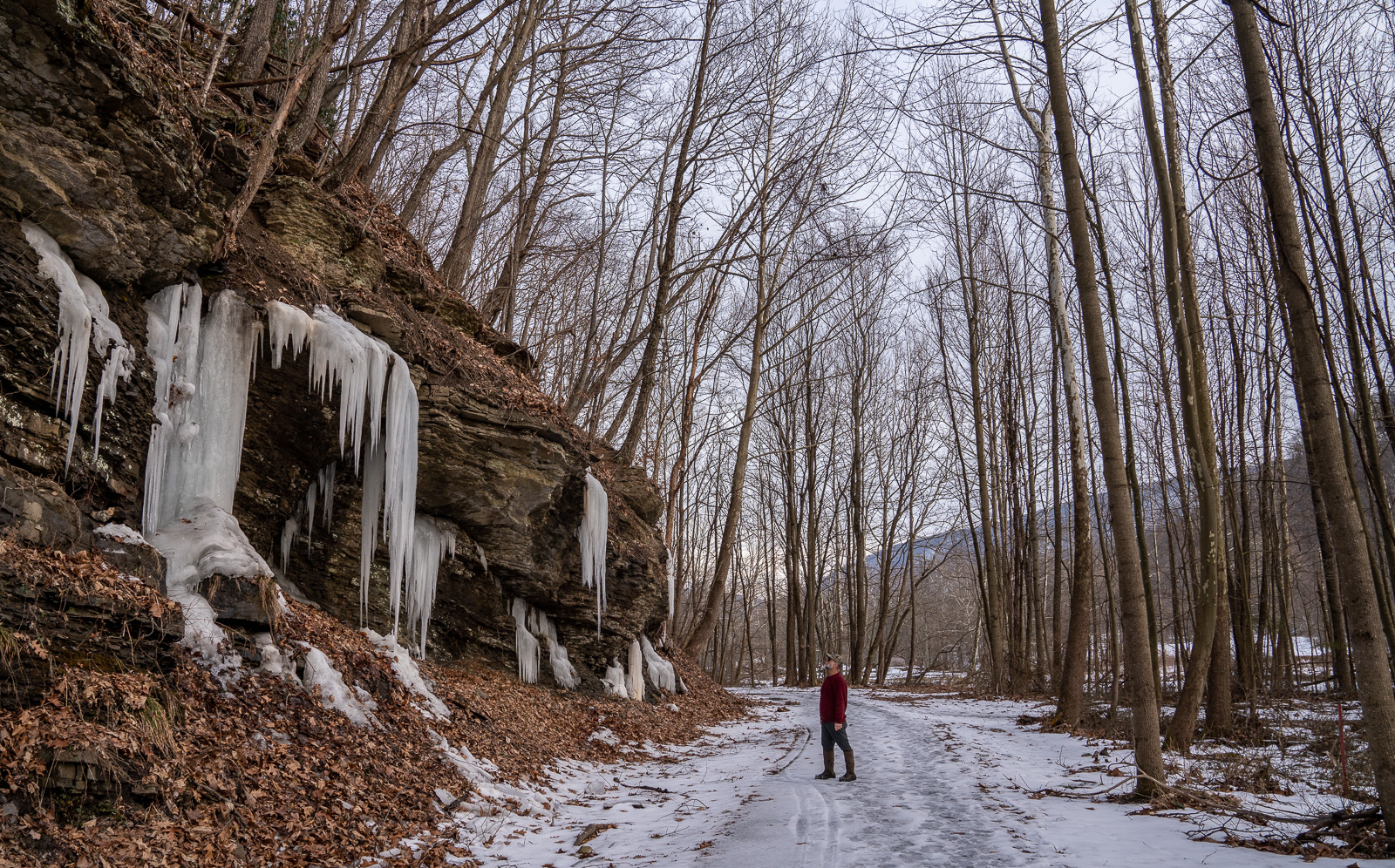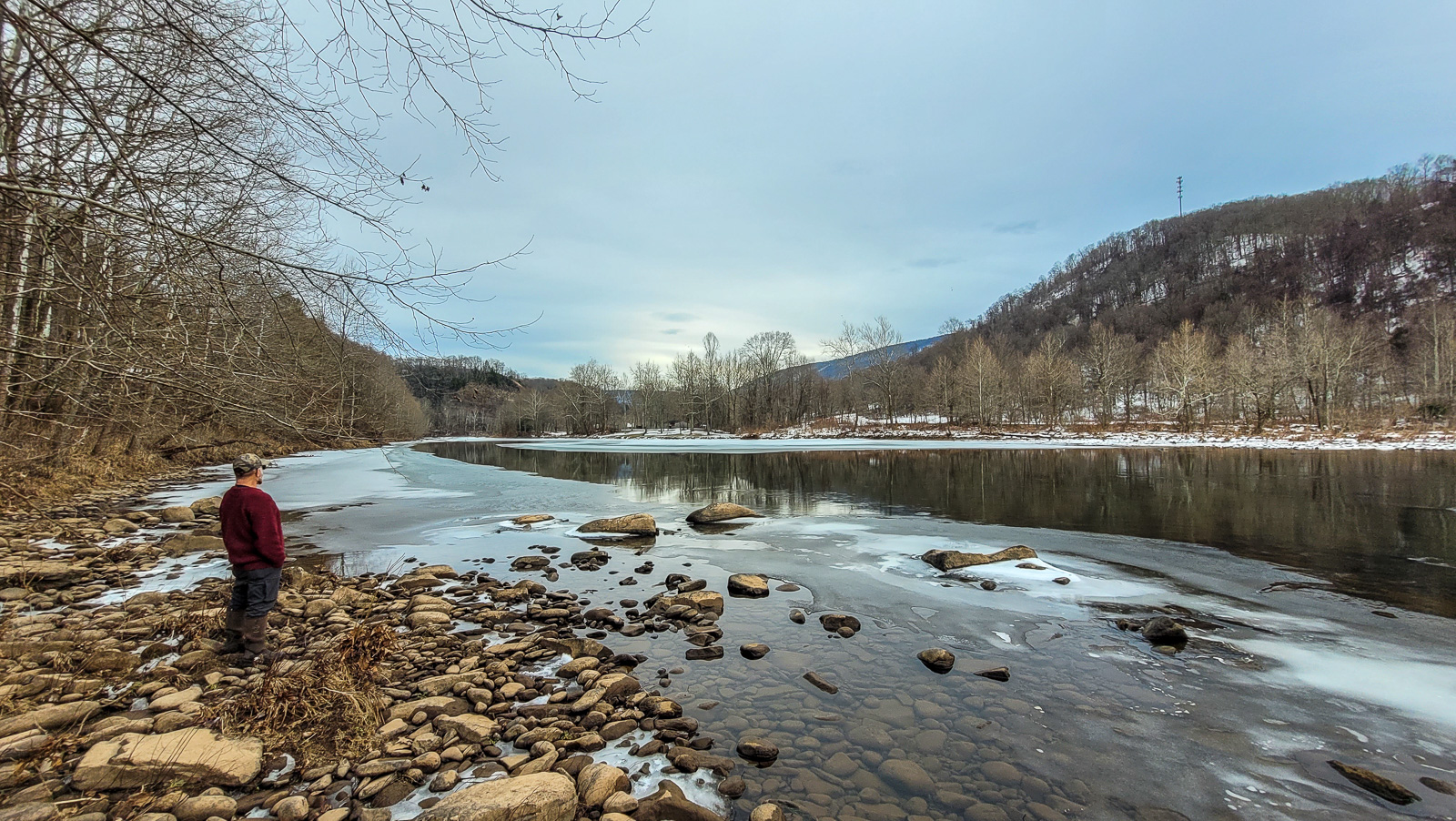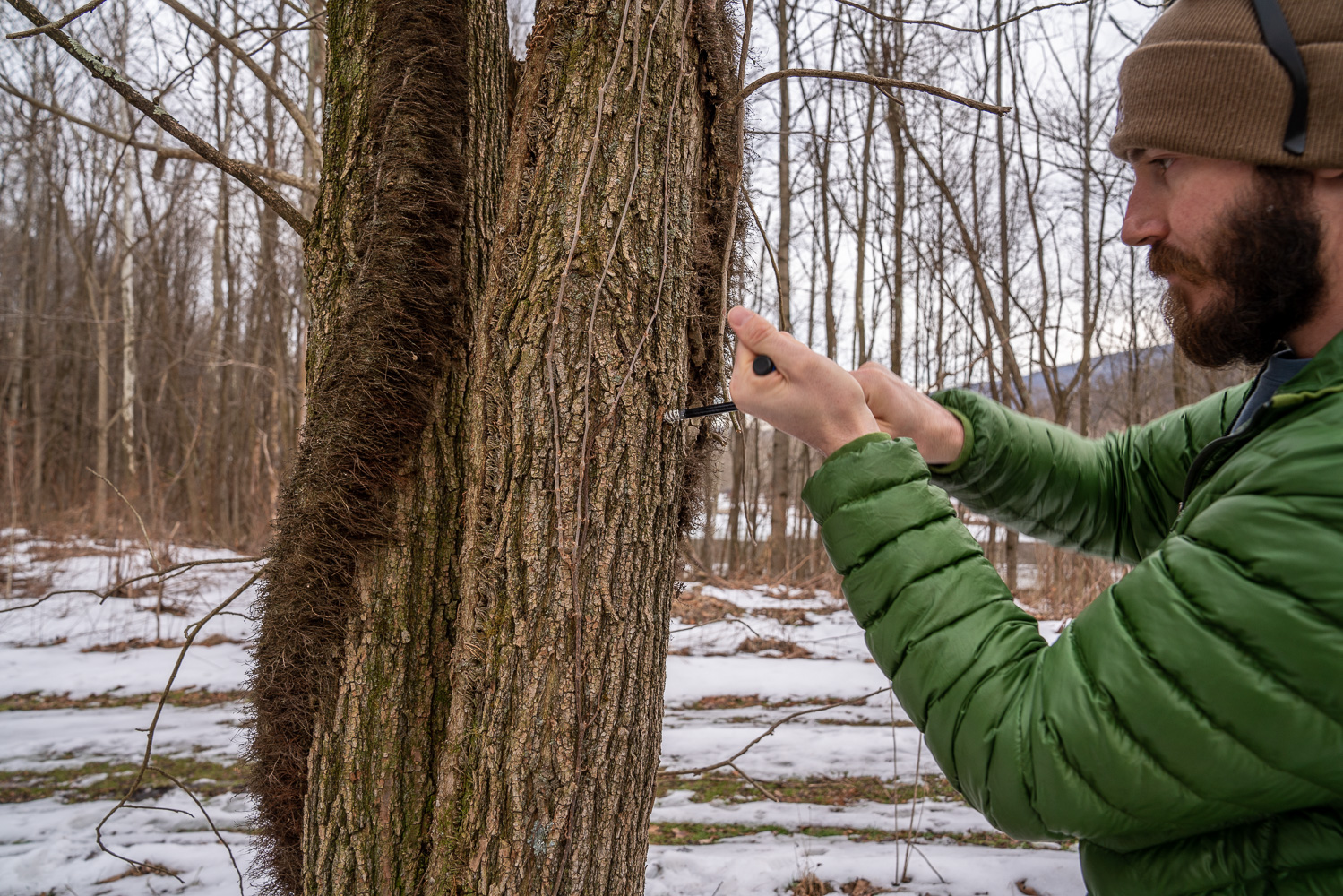
The Blackwater Canyon Trail contains plenty of scenery and eastern black walnut trees before its terminus in the tiny town of Hendricks. Photo by Dylan Jones
Note: We are thrilled to feature this article from Dylan Jones, who volunteered with us for the Timber Tracking: Eastern Black Walnut project. Read the article here or where it was originally published in Highland Outdoors, West Virginia’s only independent outdoor magazine.
Our feet crunched along the snowy path as we stared up at the small forest canopy. I stopped at a decently large tree, its straight trunk criss-crossed with ridges of thick, gray bark. “What about this one,” I asked my good friend Frank Slider. As a certified West Virginia Master Naturalist, Frank knows his trees. He also knows his spring ephemerals, flowering shrubs, berries, mosses, and mushrooms, and, well, pretty much everything else you can find in the hills and hollows of the Mountain State.
“Pretty sure that’s a black locust,” Frank returned with a hint of uncertainty as he stared intently at the fissures in the bark. “You can look around the base of the trunk for debris,” he added. Identifying deciduous trees in the winter isn’t always about looking up, and this was my crash course in how to identify eastern black walnut (Juglans nigra) in the dormant season–meaning the tree has effectively shut down and offers no leaves with which to aid the observer.
We were acting as citizen scientists, searching for eastern black walnut trees to geolocate and sample for the Adventure Scientists Timber Tracking Project—a project that seeks to create a database of genetic signatures of tree species that are targeted by illegal logging operations.
We humans are curious creatures who rely on the incredible neurological processes of pattern recognition to find our way through and survive in the world. But with all senses flaring, it’s easy to lose sight and get lost in the hunt. I stopped scanning for a moment to take it all in and refocus my brain.

Forming at the confluence of the Dry Fork and the Blackwater rivers, the Black Fork River flows for just two miles before its confluence with the Shavers Fork, making it West Virginia’s shortest river. Photo by Dylan Jones
A classic overcast winter sky lay draped over the ancient rolling ridges of Appalachia. Here in the Allegheny Mountains of West Virginia, nearly every interesting superlative ends with “east of the Mississippi.” My nostrils iced up with each inhalation of the frozen air being steadily ushered down the gorge of the Black Fork River, which drains some of the highest terrain in Alleghenies. Forming at the confluence of the Dry Fork and Blackwater rivers, the Black Fork flows just two miles–making it West Virginia’s shortest river–before reaching its confluence with the Shavers Fork River (the highest river east of the Mississippi–see?) in the rural town of Parsons.
After regaining my bearings, I began scanning the ground. The sound of the river riffling over its shallow bottom created a pleasantly ambient soundscape, providing a moment of zen as we scoured the leaf litter for evidence of walnut husks. “Here’s some shells,” Frank shouted from down the trail. Just as he found his nutshell, I noticed a sapling with branches and twigs at head-height. I grabbed one of the soft and slender twigs in my hand, bringing it close to my face to discover the black walnut’s tell-tale “monkey face” leaf scar, which features three vascular bundles that once sent nutrients to the stem that has since fallen from the twig.
Having successfully identified several black walnuts, it was time to get to work collecting various data points: geographical location, tree measurements, twigs, and a core sample chock full of unique DNA. Frank stood by and took photos while I followed the dormant season sampling protocol.
“Man, this is legit,” Frank said as I pulled out the sampling kit containing all the accouterments—bar-coded envelopes, measuring tape, a fun saw-toss tool, an increment borer, beeswax, alcohol wipes, and silica desiccant—required to complete the process.
After sampling, labels are scanned and the location is recorded via smartphone, and samples are sent back to Adventure Scientists, where the Timber Tracking database is built to aid in the fight against illegal logging. So far, Adventure Scientists has completed data collection for five threatened species: bigleaf maple, western redcedar, Alaska yellow cedar, coast redwood, and most recently, eastern black walnut.
According to Adventure Scientists’ Volunteer Manager Katya Koepsel, forest forensics is an up-and-coming field that can help prevent poachers from funneling illegal harvests into the global wood supply. Eastern black walnut, highly coveted for its richly colored and straight-grained wood, was once widely distributed across the country, but is now in decline as high lumber prices have ramped up the illicit efforts of timber poachers.
Human DNA is unique, meaning typical criminal forensics are used to match a DNA sample to its individual owner. But with trees, regional genetic markers exist within communal sections of a species’ range. Forest forensics uses those regional genetics to help match a tree to a specific location throughout its range. “Those genetic markers are going to be different between Vermont and Florida,” Koepsel said. “When a volunteer goes out and finds a tree and gets GPS coordinates to associate the tree with its genetic markers, that enables [law enforcement] to have a certain degree of confidence in identifying where the poached tree came from.”
When it comes to timber poaching, location matters–lumber can be stolen from privately owned land or public lands like state or national forests or parks. “If the genetics match those of a stand from a national park, that’s going to be a big red flag,” Koepsel said.
In 2004, the first case of forest genetics being successfully used to catch illegal logging played out in Indiana after researchers at Purdue University were able to match the genetic material from eastern black walnut and black cherry logs seized by authorities at a lumber yard to their original stumps over 60 miles away.
The first use of forest forensics in a federal criminal trial came in 2021 after a group of timber poachers in Washington State’s Olympic National Forest unintentionally started a massive forest fire in 2018 while trying to burn a wasp nest after cutting bigleaf maple trees under the cover of night. Tree DNA showed that timber they cut and sold to a local mill matched that of several stumps from the area where the fire had been started.
Also in 2021, two siblings in a suburb of Cleveland were charged with grand theft after chopping down and trying to sell timber from an eastern black walnut tree that they claimed was on their property but was actually on public city park property. Although forest genetics were not used in this case, the tree’s estimated value of over $28,000 helps to illustrate why timber poaching is occurring at an alarming rate.
But eastern black walnut isn’t just prized by crafty criminals for its wondrous wood. The tree’s seasonal nuts are a delicacy and its sap can be tediously processed into syrup. Interestingly, the black walnut’s attributes aren’t all desirable: the species possesses fascinating natural properties as well. Black walnut is an allelopathic plant, meaning it secretes toxic chemicals that harm neighbors and prevent competition. Juglans nigra’s special cocktail is hydrojuglone, a nontoxic chemical that converts to toxic juglone when exposed to air. Juglone is insoluble in water and causes wilting of foliage in susceptible plants like woody shrubs and pines.
After I completed the detailed steps of the sampling protocol, I sealed the envelope and walked down to shoot some photos of the Black Fork River. While taking in the stunning setting, I thought back to previous adventures during which I collected data for Adventure Scientists. From searching for pikas in the mountains of the American West to collecting water samples for the Global Microplastics project in Thailand, Costa Rica, Patagonia, and right here in West Virginia, contributing data to various Adventure Scientists projects has been at the core of my travels for a decade.

The author takes a core sample from a mature eastern black walnut tree. Photo by Frank Slider
Even though I was just a handful of casual miles from home after a half-day of work, I felt the same rush of excitement and accomplishment as I did while bottling glacial runoff on an untrodden trekking route in Chilean Patagonia. That is what’s so beautifully transcendent about citizen science–being part of something much larger than your own selfish outdoor pursuits adds intangible value to even the most mundane of outings.
Decades of tired adventure writing tropes, focused solely on the self, have taught us that adventure is all about the journey, not the destination. But science is science and field work is important, regardless of the location or the journey required to get there. By beautifully blending the two concepts in its name, Adventure Scientists helps to show that sometimes, the destination–in this case, stopping illegal logging–is paramount to the journey. If you’re interested in participating in citizen science, check out the ongoing projects at www.adventurescientists.org.
Dylan Jones lives with his wife Nikki in Canaan Valley, West Virginia, where they publish Highland Outdoors magazine and cross-country ski as much as the fleeting Appalachian winters allow.
About the author: Dylan Jones has been falling and hurting himself while climbing, biking, paddling, and skiing across West Virginia for over three decades. He got hooked on adventure sports while earning his bachelor’s degree in Journalism at West Virginia University. After several international adventure trips and completing a Master of Public Administration degree back home at WVU, Dylan embarked on a freelance writing career that quickly led to the position of managing editor at Highland Outdoors while under the direction of magazine founder Eric Lee. Dylan took the reins from Lee in October of 2018, and the rest is history that’s still being written on a quarterly basis.
